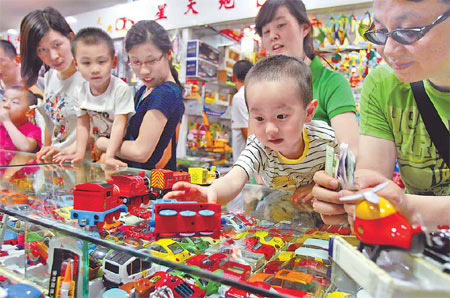Society
Tests discover heavy metals polluting toys
By Cheng Yingqi (China Daily)
Updated: 2011-05-31 07:05
 |
Large Medium Small |
|
 Toying around Two-year-old Chen Tianhao chooses his favorite toys on Monday at Beijing's Tianyi Wholesale Market. Nearly one in 10 toys in China failed to pass quality inspection tests conducted recently. [Photo by Wang Jing / China Daily] |
BEIJING - Nearly one toy in 10 failed to pass a recent quality inspection, according to the latest sampling results released by the General Administration of Quality Supervision, Inspection and Quarantine.
On May 27, the administration published the results of the tests on its website, saying 20 of the 242 toys it picked at random at markets in Hebei, Shanghai, Jiangsu, Zhejiang, Fujian, Shandong, Hubei and Guangdong did not meet national mandatory quality requirements.
Among the substandard toys, 12 were found to have sharp edges that could hurt a child, two contained heavy metals such as lead and chromium, and others had dangerous protuberances.
Heavy metals contained in toys can cause chronic poisoning if they accumulate in the human body, according to Hu Xiaohong, a pediatrician at the No 304 Hospital in Beijing.
The inspection also sampled children's shoes and bicycles made in China, of which 17.5 percent of the sampled shoes and 20 percent of the bicycles were detected as having safety problems, such as containing excessive formaldehyde and having poor durability.
"I'm not really worried so much about the visible defects in quality, such as sharp edges. What is really frightening is the invisible danger, like the heavy metals," said Shen Yin, a 60-year-old Beijing resident who looks after her grandson.
Every year on Children's Day, which falls on June 1, Shen's 3-year-old grandson receives a number of toys from relatives. She said she is always worried about their safety.
"Some toys have very tiny parts that children could swallow, others have the unpleasant smell of plastics. I have to sort out the toys that my grandson cannot play with, or that he can only play with when accompanied by adults," Shen said.
"But I had never heard of the problem of heavy metals in toys. Now, maybe, I will have to stop him from chewing on toys."
And heavy metals may not be the only harmful substance contained in toys.
Earlier this month, the environmental organization Greenpeace released the results of research it carried out on toys sampled in Beijing, Shanghai, Guangzhou and Hong Kong. Some 70 percent were found to contain phthalates.
Phthalates were once widely used in plastics to increase their flexibility, transparency and durability, but use of the substance was phased out in the United States, Canada and the European Union because of health concerns.
Shi Jianghong, an endocrine disruptor professor with Beijing Normal University, said children may consume phthalate when chewing toys and phthalate acts like female estrogen after it has entered the human body.
"It is a potentially dangerous substance that may result in hormone disruption but it is still a question whether endocrine disruptors in toys can harm a child's reproductive organs directly," Shi said.
Although toys for export are required to meet the safety standards of the importing countries, most of which restrict the use of phthalate, the rules for toy selling on the domestic market are loose.
"Following the national mandatory requirement, we mainly test toys for such things as heavy metals contained in the paint or the safety of machinery, instead of the chemical composition of toys," said Zhang Tieyan, a senior engineer in the toy department under the China Quality Certification Center.
The current national standard, GB6675-2003, has not been revised since 2003.